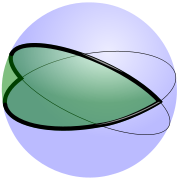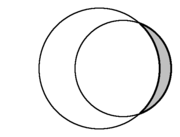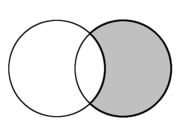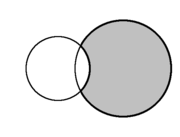.gif)
Lune (mathematics)
Encyclopedia
In geometry
, a lune is either of two figures, both shaped roughly like a crescent Moon
. The word "lune" derives from luna, the Latin word for Moon.
, a lune is the concave-convex area bounded by two circular arcs, while a convex-convex area is termed a lens
.
Formally, a lune is the relative complement of one disk
in another (where they intersect but neither is a subset of the other). Alternatively, if A and B are disks, then is a lune.
is a lune.
 In spherical geometry
In spherical geometry
, a lune is an area on a sphere bounded by two half great circles, which is also called a digon
or a diangle or (in German) a Zweieck. Great circles are the largest possible circles on a sphere
; each great circle divides the surface of the sphere into two equal halves. Two great circles always intersect at two polar opposite points. Common examples of great circles are lines of longitude
(meridians), which meet at the North
and South Pole
s. Thus, the area between two meridians of longitude is a lune. The area of a spherical lune is 2θ R2, where R is the radius of the sphere and θ is the dihedral angle
between the two half great circles. When this angle equals 2π — i.e., when the second half great circle has moved a full circle, and the lune in between covers the sphere — the area formula for the spherical lune gives 4πR2, the surface area of the sphere.
 The lighted portion of the Moon
The lighted portion of the Moon
visible from the Earth
is a spherical lune. The first of the two intersecting great circles is the terminator
between the sunlit half of the Moon and the dark half. The second great circle is that which separates the half visible from the Earth from the invisible half. This lighted spherical lune produces the familiar crescent shape of the Moon seen from Earth, the intersection of a semicircle and semi-ellipse (with the major axis of the ellipse coinciding with the diameter of the circle), as illustrated in the figure on the left.
showed that certain lune
s, could be exactly squared by straightedge and compass. See Lune of Hippocrates
.
Geometry
Geometry arose as the field of knowledge dealing with spatial relationships. Geometry was one of the two fields of pre-modern mathematics, the other being the study of numbers ....
, a lune is either of two figures, both shaped roughly like a crescent Moon
Moon
The Moon is Earth's only known natural satellite,There are a number of near-Earth asteroids including 3753 Cruithne that are co-orbital with Earth: their orbits bring them close to Earth for periods of time but then alter in the long term . These are quasi-satellites and not true moons. For more...
. The word "lune" derives from luna, the Latin word for Moon.
Plane geometry
In plane geometryPlane geometry
In mathematics, plane geometry may refer to:*Euclidean plane geometry, the geometry of plane figures,*geometry of a plane,or sometimes:*geometry of a projective plane, most commonly the real projective plane but possibly the complex projective plane, Fano plane or others;*geometry of the hyperbolic...
, a lune is the concave-convex area bounded by two circular arcs, while a convex-convex area is termed a lens
Lens (geometry)
In geometry, a lens is a biconvex shape comprising two circular arcs, joined at their endpoints. If the arcs have equal radii, it is called a symmetric lens.A concave-convex shape is called a lune...
.
Formally, a lune is the relative complement of one disk
Disk (mathematics)
In geometry, a disk is the region in a plane bounded by a circle.A disk is said to be closed or open according to whether or not it contains the circle that constitutes its boundary...
in another (where they intersect but neither is a subset of the other). Alternatively, if A and B are disks, then
 is a lune.
is a lune.  |
 |
 |
 |
 |
 |
| In plane geometry, the crescent shape formed from two intersecting circles is called a lune (in gray). There are two lunes in each diagram only one of which is shaded | ||
Spherical geometry

Spherical geometry
Spherical geometry is the geometry of the two-dimensional surface of a sphere. It is an example of a geometry which is not Euclidean. Two practical applications of the principles of spherical geometry are to navigation and astronomy....
, a lune is an area on a sphere bounded by two half great circles, which is also called a digon
Digon
In geometry, a digon is a polygon with two sides and two vertices. It is degenerate in a Euclidean space, but may be non-degenerate in a spherical space.A digon must be regular because its two edges are the same length...
or a diangle or (in German) a Zweieck. Great circles are the largest possible circles on a sphere
Sphere
A sphere is a perfectly round geometrical object in three-dimensional space, such as the shape of a round ball. Like a circle in two dimensions, a perfect sphere is completely symmetrical around its center, with all points on the surface lying the same distance r from the center point...
; each great circle divides the surface of the sphere into two equal halves. Two great circles always intersect at two polar opposite points. Common examples of great circles are lines of longitude
Longitude
Longitude is a geographic coordinate that specifies the east-west position of a point on the Earth's surface. It is an angular measurement, usually expressed in degrees, minutes and seconds, and denoted by the Greek letter lambda ....
(meridians), which meet at the North
North Pole
The North Pole, also known as the Geographic North Pole or Terrestrial North Pole, is, subject to the caveats explained below, defined as the point in the northern hemisphere where the Earth's axis of rotation meets its surface...
and South Pole
South Pole
The South Pole, also known as the Geographic South Pole or Terrestrial South Pole, is one of the two points where the Earth's axis of rotation intersects its surface. It is the southernmost point on the surface of the Earth and lies on the opposite side of the Earth from the North Pole...
s. Thus, the area between two meridians of longitude is a lune. The area of a spherical lune is 2θ R2, where R is the radius of the sphere and θ is the dihedral angle
Dihedral angle
In geometry, a dihedral or torsion angle is the angle between two planes.The dihedral angle of two planes can be seen by looking at the planes "edge on", i.e., along their line of intersection...
between the two half great circles. When this angle equals 2π — i.e., when the second half great circle has moved a full circle, and the lune in between covers the sphere — the area formula for the spherical lune gives 4πR2, the surface area of the sphere.

Moon
The Moon is Earth's only known natural satellite,There are a number of near-Earth asteroids including 3753 Cruithne that are co-orbital with Earth: their orbits bring them close to Earth for periods of time but then alter in the long term . These are quasi-satellites and not true moons. For more...
visible from the Earth
Earth
Earth is the third planet from the Sun, and the densest and fifth-largest of the eight planets in the Solar System. It is also the largest of the Solar System's four terrestrial planets...
is a spherical lune. The first of the two intersecting great circles is the terminator
Terminator (solar)
A terminator, twilight zone or "grey line" is a moving line that separates the illuminated day side and the dark night side of a planetary body...
between the sunlit half of the Moon and the dark half. The second great circle is that which separates the half visible from the Earth from the invisible half. This lighted spherical lune produces the familiar crescent shape of the Moon seen from Earth, the intersection of a semicircle and semi-ellipse (with the major axis of the ellipse coinciding with the diameter of the circle), as illustrated in the figure on the left.
Lune of Hippocrates
In the 5th century BC, Hippocrates of ChiosHippocrates of Chios
Hippocrates of Chios was an ancient Greek mathematician, , and astronomer, who lived c. 470 – c. 410 BCE.He was born on the isle of Chios, where he originally was a merchant. After some misadventures he went to Athens, possibly for litigation...
showed that certain lune
Lune
Lune or Luna is a poetic name for Earth's Moon. Lune is French for Moon. Luna is Latin for Moon.It may also refer to:* Rivers:** River Lune in Lancashire and Cumbria, England** River Lune in England...
s, could be exactly squared by straightedge and compass. See Lune of Hippocrates
Lune of Hippocrates
In geometry, the lune of Hippocrates, named after Hippocrates of Chios, is a lune bounded by arcs of circles, one of which passes through the center of the other and has half the area of the other...
.
See also
- ArbelosArbelosIn geometry, an arbelos is a plane region bounded by a semicircle of diameter 1, connected to semicircles of diameters r and , all oriented the same way and sharing a common baseline. Archimedes is believed to be the first mathematician to study its mathematical properties, as it appears in...
- Spherical geometrySpherical geometrySpherical geometry is the geometry of the two-dimensional surface of a sphere. It is an example of a geometry which is not Euclidean. Two practical applications of the principles of spherical geometry are to navigation and astronomy....
- Gauss–Bonnet theorem
External links
- The Five Squarable Lunes at MathPages

